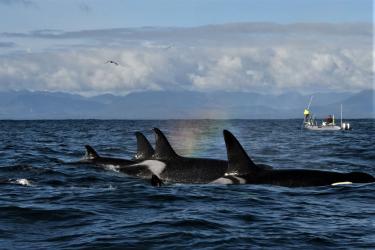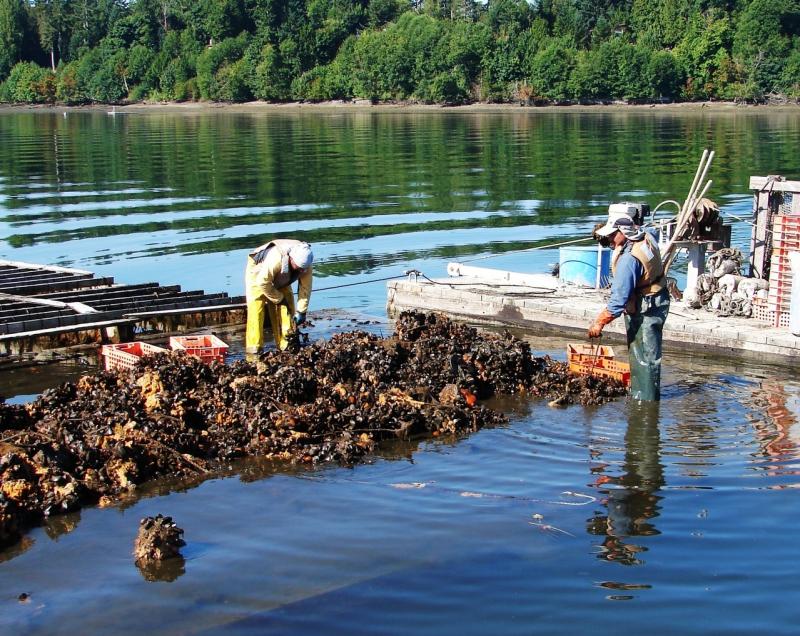Aquaculture producers work at all hours in all conditions, with weathered hands flipping oyster cages, plucking fresh kelp from their lines and tending net pens. These aquaculture producers are also committed stewards of the environment, managing their farms with sustainability in mind. In these Tide to Table Profiles, aquaculture farmers explain the stewardship and care that goes into keeping their crop as well as their businesses alive. Learn more about aquaculture and try a recipe idea straight from the farmers.
Atlantic Tide to Table Aquaculture Profiles
The U.S. aquaculture industry produced $1.5 billion worth of seafood in 2017, with 39 percent of that value coming from the Atlantic region. Along the Atlantic coast, these small businesses are helping to serve as a model of sustainability in aquaculture.
Bangs Island Mussels
Bangs Island Mussels raises shellfish and seaweed in Maine’s Casco Bay, using a space-efficient process called rope growing. Mussels provide ecosystem benefits by removing excess nutrients from the water as they grow.
Get to know Bangs Island Mussels
Madhouse Oysters
On a tiny chain of islands in Maryland’s Chesapeake Bay, Madhouse Oysters cultivates the Eastern Oyster. Entrepreneurial shellfish farms like this one provide sustainable jobs for the local community.
Pacific Tide to Table Aquaculture Profiles
Pacific aquaculture production is very diverse. Key nearshore shellfish species include oysters, clams, and land-based facilities growing red abalone. Offshore species include Mediterranean mussels, rock scallops, finfish, and a variety of seaweeds. Aquaculture enterprises in the region are helping expand access to fresh seafood and year-round aquaculture jobs.
Chelsea Farms
Chelsea Farms is a family-owned enterprise that is making great strides toward restoring the population of native oysters in Washington's South Sound.
The Cultured Abalone Farm
In California's Santa Barbara Channel, The Cultured Abalone Farm raises red abalone using state-of-the-art tanks, water from the channel, and locally harvested seaweed.
Get to know The Cultured Abalone Farm
Kualoa Ranch
On the island of Oahu, Kualoa Ranch provides sustainable food opportunities and continues the tradition of Hawaiian fishpond aquaculture.
Seagrove Kelp Co.
Kelp farms like Seagrove Kelp Co. are still fairly novel in Alaska, but this fast-growing industry is already increasing year-round job opportunities along the coast.
Gulf of Mexico Tide to Table Aquaculture Profiles
Aquaculture in the Gulf of Mexico focuses on stock enhancement to supplement wild populations, seafood production, research, and restoration efforts. Species cultured in the region include oysters, clams, shrimp, red drum, almaco jack, spotted seatrout, pompano, black seabass, and algae. In the favorable Gulf climate, aquaculture farmers produced more than 24.9 million pounds of shellfish in 2017.
Pelican Oyster Co.
In the Gulf of Mexico near Florida's Big Bend, the Pelican Oyster Co.'s crop of "Salty Bird" oysters filter the water and help other species flourish.
Get to know Pelican Oyster Co.
Sustainable Seafood from Tide to Table
The Tide to Table series profiles members of the aquaculture community, who provide valuable jobs and increase access to fresh, sustainably sourced seafood in the United States. Aquaculture is about more than just seafood production. It is about ecosystem stewardship, coastal communities, and economic opportunities.











